
https://www.youtube.com/watch?v=Hjlu-jIY9Ao
#1 Sign That You Overdosed on Vitamin D
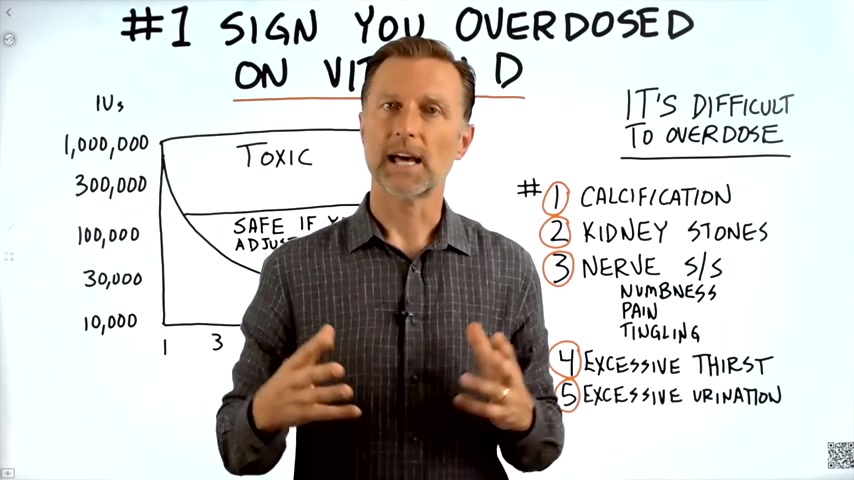
I'd like to discuss the number one sign or symptom that could occur if you have overdosed on your vitamin d .
But before I get into this , I just have to say something .
The danger or the side effects of not having enough vitamin d are about a 1000 times more than having toxicity or too much vitamin d .
So that being said , it's very difficult to overdose with vitamin d .
Let me just jump right in .
I have this chart right here , and it's not scaled perfectly , but it'll give you the rough idea of what this means .
So down here , we have weeks .
We have 1 week , 3 weeks , 10 weeks , 30 weeks , and a 100 weeks .
Okay ?
Now how many weeks are in a year ?
52 .
Right ?
So that's gonna be somewhere in here , so you can see it's not scaled correctly .
Now , on the left side of this graph , you have international units of vitamin d .
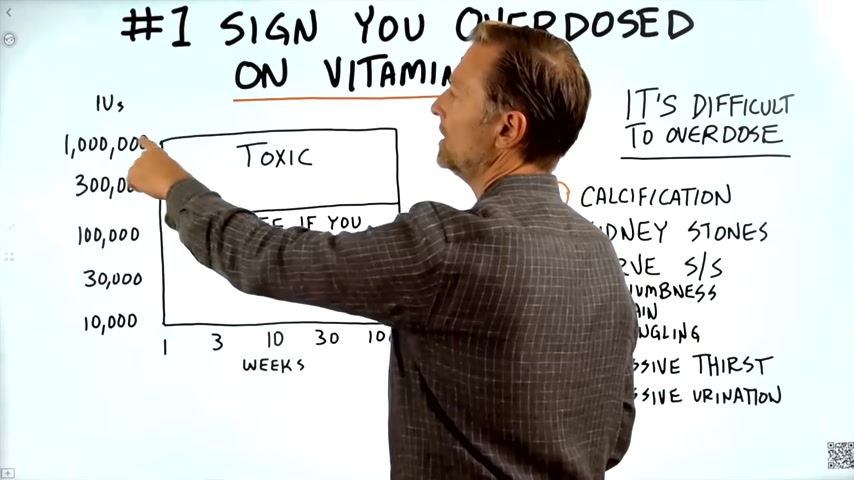
So , up here at the top we have a 1000000 international units and we have 300,000 international units .
We have 100,000 , 30,000 , 10,000 .
Now , right now , you might be taking , I don't know , 600 IU's or a 1000 IU's or maybe 2,000 IU's of your vitamin d .
It's , like , not even on this chart .
This starts at 10,000 IUs , and this is what I recommend even as a maintenance dosage .
So you could see , even at 10,000 IUs , a 100 weeks , there's no toxicity at all .
And we get to 30,000 , okay , all the way to here , maybe , up to , like , maybe 10 weeks .
There could be some potential side effects .
Right ?
10 weeks .
And then we have a 100,000 , right , for maybe two and a half weeks , it's fine .
Even 300,000 units for a week is fine , but there's this little section which I'm going to explain right here .
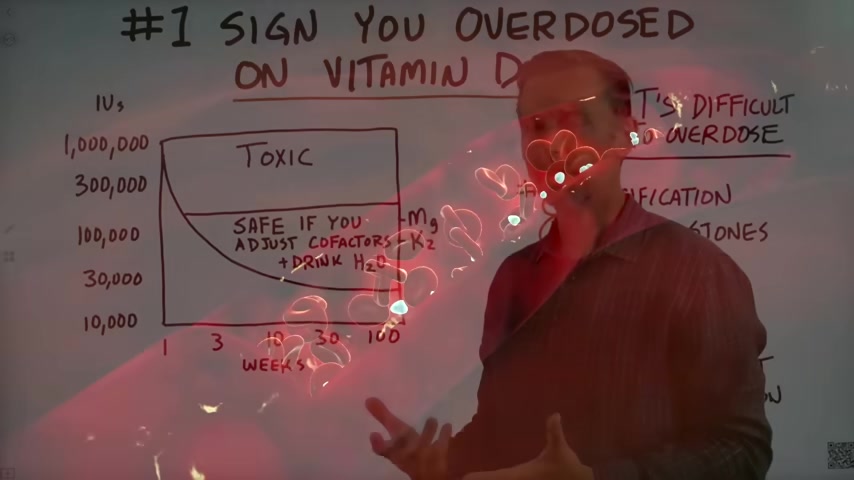
This area right here is safe if you adjust the cofactors .
Now , what does it mean cofactors ?
It means that vitamin d always works with other factors that help it in its function and absorption , etcetera .
And there's 2 really big cofactors , magnesium and vitamin k 2 .
And there's other ones too , like zinc and maybe b 6 that help to keep it safer and keep it from becoming toxic .
For example , if you take a lot of vitamin d , it helps you absorb calcium into the blood by 20 times , because that's what it does .
And now you have all this extra calcium in the blood .
Well , vitamin k 2 will take it from the blood and transport it into the bone .
So having enough k2 with d3 buffers it and keeps it from creating a problem .

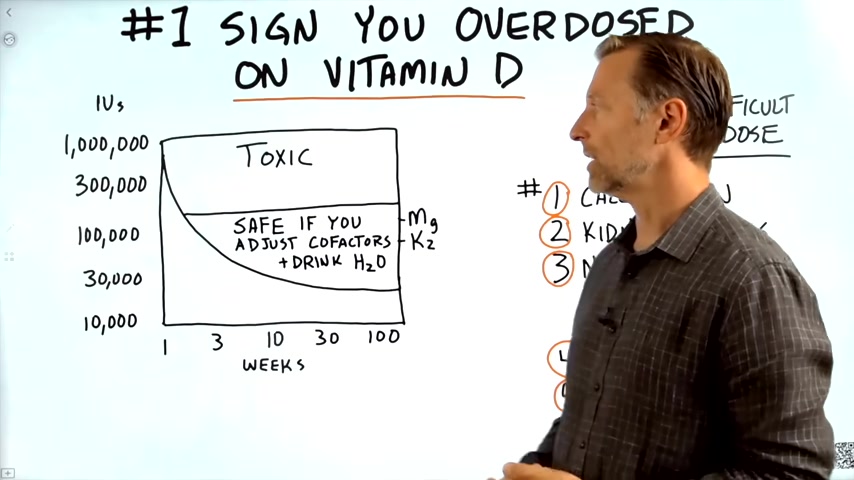
And so this section right here is safe if you adjust the cofactors , and also if you drink more water because the big problem with too much calcium is kidney stones .
That's one of the symptoms .
It's not the top one .
It's number 2 , which I'll get to .
But if you drink enough water , like 2 and a half liters of fluid , the odds of you getting kidney stones go down to 0 .
Why ?
Because kidney stones occur when you have a super concentrated amount of calcium .
And if you're drinking enough water , there's no way the calcium can be super concentrated anymore .
So you can actually prevent that problem .
But , typically , the toxicity effect from vitamin d really occurs when you're taking 100 of 1,000 of international units of vitamin d for many , many weeks .
Okay ?
Now that being said , the number one sign would be calcification somewhere in your body .
Now what's common for women is calcification in the breast tissue .
Right ?
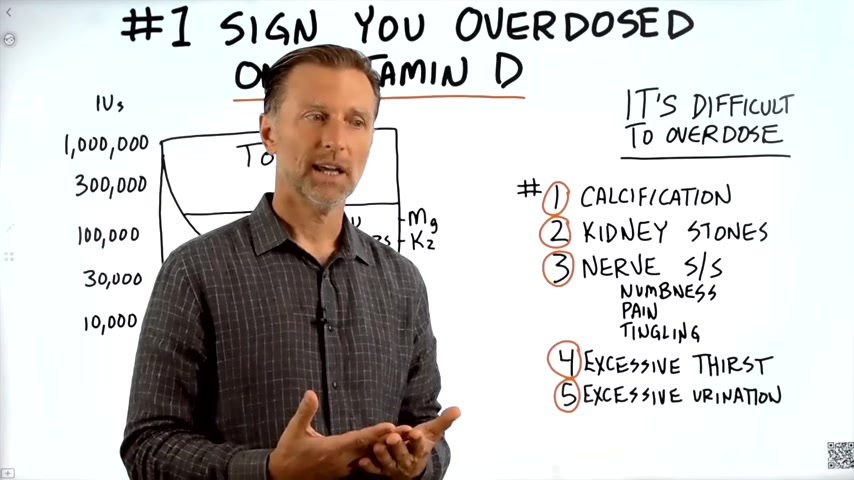
That's kind of a benign situation .
Doesn't create any problems , but it can occur .
You can have calcification in any organ or tissue .
So that would be the first sign that you have too much vitamin d .
Number 2 , kidney stones .
Okay ?
But , of course , kidney stones could come from many different things .
Number 3 , nerve symptoms like numbness , pain , tingling , any type of weird type symptoms with your nerves , that could be a sign that you have too much vitamin d .
And number 4 is excessive thirst .
Okay ?
And number 5 , excessive urination .
Both of these .
Now Now what's interesting about these 2 is you usually get these symptoms when you're a diabetic , but in this situation , it's where you have too much calcium because the vitamin d is too high .
So there you have it .
These are the symptoms .
But I wanna show you something that relates to toxicity , I think .
This is my theory .
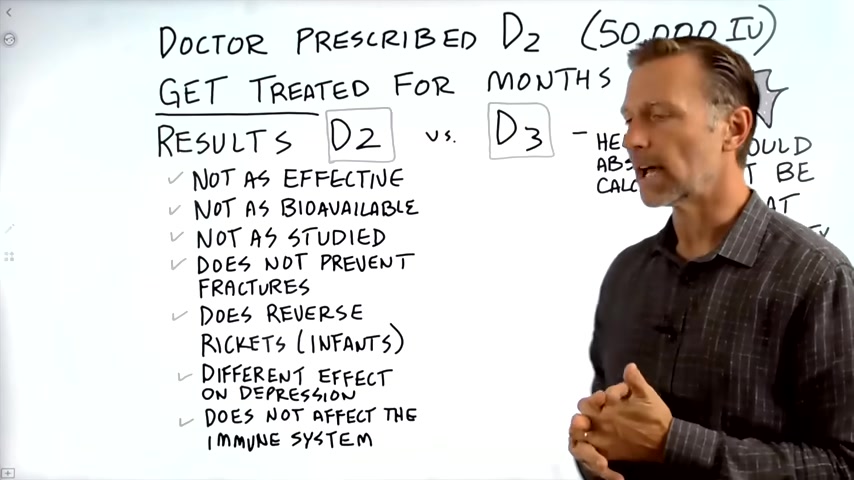
I think , a lot of the cases that you hear about with toxicity are from vitamin d 2 , not vitamin d 3 .
You see , the doctors usually prescribe vitamin d 2 , not d 3 .
K ?
They'll usually give you , like , 50,000 international units of vitamin d 2 once a week .
And there's some really big differences between vitamin d 2 and d 3 that I'm gonna explain that could cause the person to take vitamin d 2 for a long period of time simply because they're not gonna really see the results .
Okay ?
Let me explain .
Let's compare d 2 to d 3 .
Well , first of all , d 2 is not as effective as d 3 .
It's not as bioavailable .
It's not as studied .

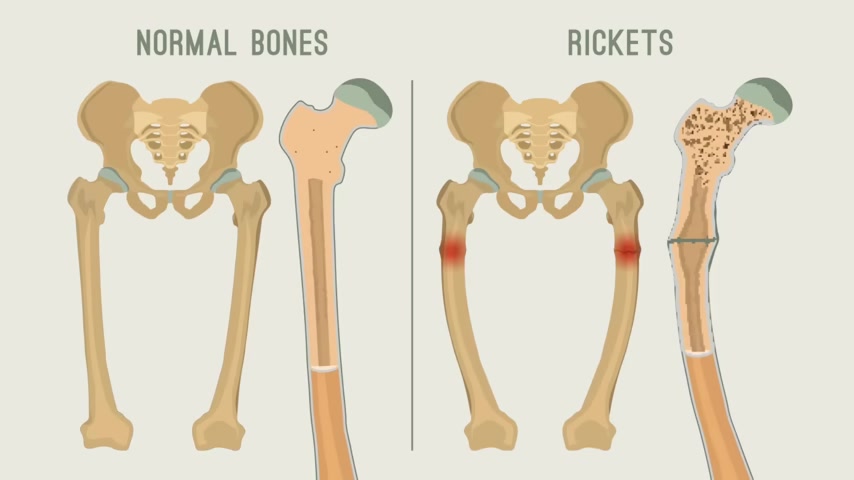
It does not prevent fractures like vitamin d 3 will , but it does reverse rickets in infants , which is a severe vitamin d deficiency .
It has a different effect on the symptom depression , which relates to a couple factors which I don't wanna necessarily get into in this video .
And this next one is very important to know , it does not affect the immune system .
Okay ?
It doesn't improve the immune system like vitamin d 3 .
Here you are taking b 2 and not seeing the results .
So maybe you'll be taking more or for a long period of time .
That potentially could be , and this is just my theory , why there is toxicity in the first place .
But again , I'm not a 100% on that , but that's just my theory .
Now since we talked about the main symptom , which is calcification , which is excess calcium , I think it's very appropriate to watch this video next right here .
Are you looking for a way to reach a wider audience and get more views on your videos?
Our innovative video to text transcribing service can help you do just that.
We provide accurate transcriptions of your videos along with visual content that will help you attract new viewers and keep them engaged. Plus, our data analytics and ad campaign tools can help you monetize your content and maximize your revenue.
Let's partner up and take your video content to the next level!
Contact us today to learn more.